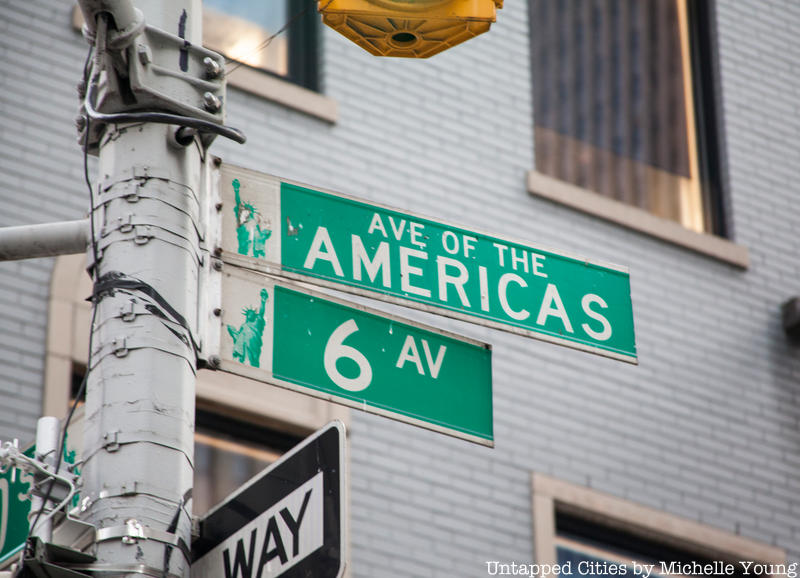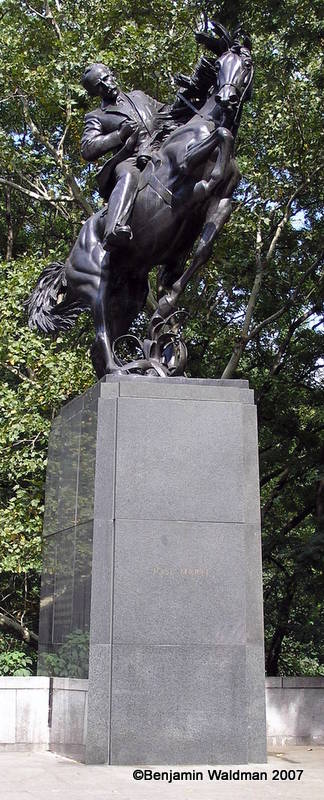
For over 70 years, Sixth Avenue has not been the official name of the avenue that can be found between Fifth and Seventh Avenues in Manhattan. On October 2nd, 1945, Mayor Fiorello H. La Guardia signed a bill ceremoniously renaming Sixth Avenue the Avenue of the Americas. Prior to that, Sixth Avenue had been the street’s name since April 1, 1811, when it replaced West Road. The City’s goal at the time was to display Pan-American friendship but almost immediately, many New Yorkers were opposed to the new name, both actively and passively.
In September 1945, when the ink was not yet dry on the City Council’s bill, there were attempts to undo the legislation. In 1955, The New York Times conducted an “impromptu survey” finding that Sixth Avenue was favored over Avenue of the Americas by a margin of 8.5 to 1. By 1965, the Avenue of the Americas Association, presented joke awards to those that had resisted switching to the new street name for over two decades. The winners included a taxi driver (on behalf of all tourists), the Sixth Avenue Deli, the editor of New Yorker and ironically, the Executive Vice President of the Avenue of the Americas Association (who had not changed the organizations name in the telephone book from the Sixth Avenue Association). The winners received a plaque and a ninepin, symbolizing Rip Van Winkle’s two decade slumber.
By 1985, Mayor Ed Koch ordered the Sixth Avenue back on the Avenue’s street signs. Since most New Yorkers are still reticent to refer to the street by its official name, a number of objects placed along the street in commemoration of its name are overlooked or their context is unknown.
Presented below are 10 objects that complement Sixth Avenue’s official name, Avenue of the Americas:
1. Jose Julian Marti Statue (Cuba)
At 11:30 on Tuesday, May 18, 1965, the statue of Cuban patriot and martyr Jose Julian Marti statue was dedicated (with a performance by the Department of Sanitation Band). The statue had a long and complicated journey to its dedication at the northern end of the Avenue of the Americas. It was the last major equestrian commission by artist Anna Hyatt Huntington, at the age of 80. Huntington was personally recruited to sculpt Marti by the Cuban Government, under Batista. She was paid $100,000 for the work, which she donated to hispanic charities. The statue was completed in May 1959 but it would take six more years for the statue to be erected.
For six years, an empty plinth stood next to the statues of San Martin and Bolivar on 59th Street. Huntington’s statue was given to the City in November 1958 or May 1959 (depending on the source) after which point it disappeared. In 1960, the Marti statue was discovered in a Bronx storage yard, strategically hidden under a tarp. The City, at the behest of the State Department and NYPD, refused to erect the sculpture out of fear it would become the site of clashes between pro and anti Castro groups. As a result of the City’s inaction, a group of Anti-Castro Cuban exiles attempted to erect a plaster model of the statue atop the plinth. Ultimately, the 600 pound statue proved too tall to hoist atop the base and it was placed next to it, with the hope that it would be too heavy for the police to move. Within hours, the police arrived and somehow confiscated the statue (as they more recently did with the Snowden and Trump statues).
By April 1965, the statue was rediscovered in a Central Park maintenance yard. When asked about its present predicament by The New York Times, a spokesperson from Mayor Robert F. Wagner’s office responded “How come you guys know where it is?” The City finally decided it was time to finally erect the sculpture. On May 18, 1965, the 70th anniversary (plus one day) of Marti’s death, the statue was dedicated in the presence of Anna Hyatt Huntington and Cesar Romero (Marti’s grandson and the actor best known for playing the Joker in the Adam West Batman series).






